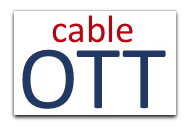
Disney is looking to create an OTT ESPN channel, @AlexWeprin writes in @MediaPost. (For those not hip to broadcast jive, OTT means Over The Top of cable. In other words, on-Net but not on-cable. Examples: YouTube, Netflix, Hulu, Amazon.) Here is my comment below that piece (the only one so far):
I'm a sports fan, and ESPN is the only reason I haven't cut the cord on cable. And I'm sure that's typical of millions of other sports fans.
But this new OTT thing doesn't interest me. It reads too much like a side show. Who are the stars, the personalities? Where's Stehpen A? Wingo and Golic? SVP? Betcha they're not on this thing, or ESPN would be talking them up.
At some point Disney and ESPN face the fact that OTT is the new bottom, and the world of video viewing will finally become what the Internet wanted it to be from the start: fully unbundled, any-to-any, at trivial connection costs, with some content free and other content costing money.
That covers the subscription side of things. Advertising will be harder, because the simple fact is that people have always hated ads (except, of course, on the Super Bowl, an irrelevant exception).
Today it is easy to skip over and around ads on streams and podcasts, so the only place left where people suffer live ads is on live sports broadcasts. But even there many people wait an hour to start watching and skip forward past the ads, expertly. (Time out? Two clicks on the —> button, :30 each. Major break? Four or eight clicks.)
Some of us now listen to ESPN radio only on podcasts, because the spot breaks are shorter it's easy to skip over them.
My point: the only final incentive alignment that will work is the one in which ads are minimized or eliminated. This has huge implications for the sizes and influences of sports broadcasters, and finally for the sizes of pro player salaries, most of which derive their heft from all those ads.
Best to start preparing now for the day of reckoning when what's obvious for viewers and listeners dawns on the supply side of the marketplace.